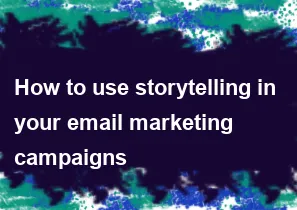How to use storytelling in your email marketing campaigns

Using storytelling in your email marketing campaigns can be a powerful way to engage your audience, create a connection with them, and ultimately drive conversions. Here are some tips on how to incorporate storytelling into your email marketing:
Know Your Audience:
- Understand your target audience's preferences, interests, and pain points. Tailor your stories to resonate with them on a personal level.
Start with a Compelling Subject Line:
- The subject line is the first thing your audience sees. Craft a subject line that sparks curiosity or emotion, encouraging recipients to open the email.
Create a Personalized Narrative:
- Share real stories about your brand, employees, or customers. Personalize the narrative to make it relatable and humanize your brand.
Use Visuals:
- Include compelling visuals, such as images or videos, to enhance your storytelling. Visual content can capture attention and convey emotions more effectively than plain text.
Craft a Compelling Opening:
- The opening of your email should immediately draw the reader in. Use a strong hook or a relatable scenario to pique their interest.
Develop a Clear Plot:
- Organize your email content like a story, with a clear beginning, middle, and end. Create a narrative flow that guides the reader through the message.
Highlight Customer Success Stories:
- Feature customer testimonials and success stories. Showcase how your product or service has positively impacted others, building trust and credibility.
Create a Sense of Urgency or Tension:
- Use storytelling to create a sense of urgency or tension that drives the reader to take action. This can be achieved by presenting a problem that your product or service solves.
Keep it Concise:
- While storytelling is important, be mindful of the length of your emails. Keep the content concise and focused to maintain the reader's attention.
End with a Call to Action (CTA):
- Close your email with a clear and compelling call to action. Direct the reader on what steps to take next, whether it's making a purchase, signing up for a webinar, or downloading a resource.
Test and Analyze:
- A/B test different storytelling approaches to see what resonates best with your audience. Analyze the performance of your email campaigns to refine your storytelling strategy over time.
Segment Your Audience:
- Tailor your stories to different segments of your audience based on their preferences, behaviors, or demographics. This personalized approach can increase the relevance of your storytelling.
Remember, effective storytelling is about creating an emotional connection and providing value to your audience. By integrating storytelling into your email marketing, you can foster stronger relationships and drive better results.
-
Popular Post
- How to optimize for Google's About This Result feature for local businesses
- How to implement multi-language support in an Express.js application
- How to handle and optimize for changes in mobile search behavior
- How to handle CORS in a Node.js application
- How to use Vue.js with a UI framework (e.g., Vuetify, Element UI)
- How to configure Laravel Telescope for monitoring and profiling API requests
- How to create a command-line tool using the Commander.js library in Node.js
- How to implement code splitting in a React.js application
- How to use the AWS SDK for Node.js to interact with various AWS services
- How to use the Node.js Stream API for efficient data processing
- How to implement a cookie parser middleware in Node.js
- How to implement WebSockets for real-time communication in React
-
Latest Post
- How to implement a dynamic form with dynamic field styling based on user input in Next.js
- How to create a custom hook for handling user interactions with the browser's device motion in Next.js
- How to create a custom hook for handling user interactions with the browser's battery status in Next.js
- How to implement a dynamic form with dynamic field visibility based on user input in Next.js
- How to implement a dynamic form with real-time collaboration features in Next.js
- How to create a custom hook for handling user interactions with the browser's media devices in Next.js
- How to use the useSWRInfinite hook for paginating data with a custom loading indicator in Next.js
- How to create a custom hook for handling user interactions with the browser's network status in Next.js
- How to create a custom hook for handling user interactions with the browser's location in Next.js
- How to implement a dynamic form with multi-language support in Next.js
- How to create a custom hook for handling user interactions with the browser's ambient light sensor in Next.js
- How to use the useHover hook for creating interactive image zoom effects in Next.js